One common motion seeks a stay while the U.S. Patent and Trademark Office resolves a narrowly focused validity dispute.
Such a stay can ultimately streamline district court proceedings because, if one or more claims is found unpatentable, the remaining issues, if any, are narrowed at the district court, or if the claims are upheld, estoppel limits the invalidity challenges that a defendant can raise in the district court.
These actions at the USPTO include inter partes reviews and post-grant reviews,1 which are adjudicated by the Patent Trial and Appeal Board.
Defendants filing these reviews should consider whether it makes sense to move to stay the litigation pending decisions from the PTAB. In making that determination, one frequently asked question is, "How likely am I to get a stay if I ask for it?"
Although all cases turn on their specific facts, it can be useful to know general trends in some of the most popular patent forums. This article provides an overview of how such motions have recently fared.
The graph below2 shows results for the 292 motions to stay pending a PTAB proceeding decided between Jan. 1, 2022, through Feb. 28, 2023.3 These motions have an overall grant rate of 79%, with 231 of the motions being granted.
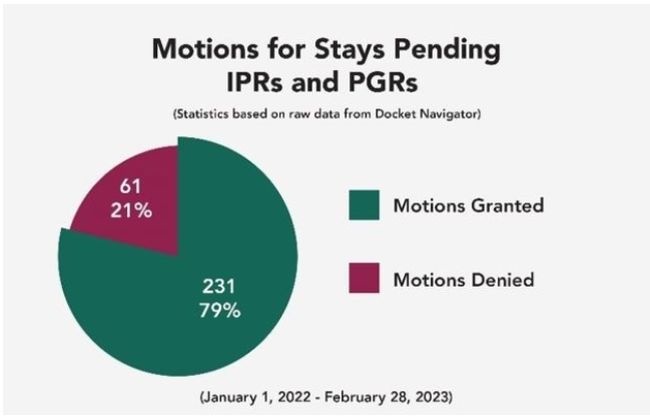
This general data, however, can be misleading because it fails to differentiate between agreed-upon stays or joint motions, where both parties jointly request the court's approval, and disputed motions, where one party opposes the stay and asks the district court to proceed in parallel with the PTAB proceeding. Opposed motions require the court to analyze the relevant facts and make a decision.
The analysis below focuses on the results of contested motions to stay in two popular district courts for patent litigation, the U.S. District Court for the District of Delaware and the U.S. District Court for the Western District of Texas, and these courts' treatments of the relevant factors. In these forums, the overall grant rate for contested motions is 47%.
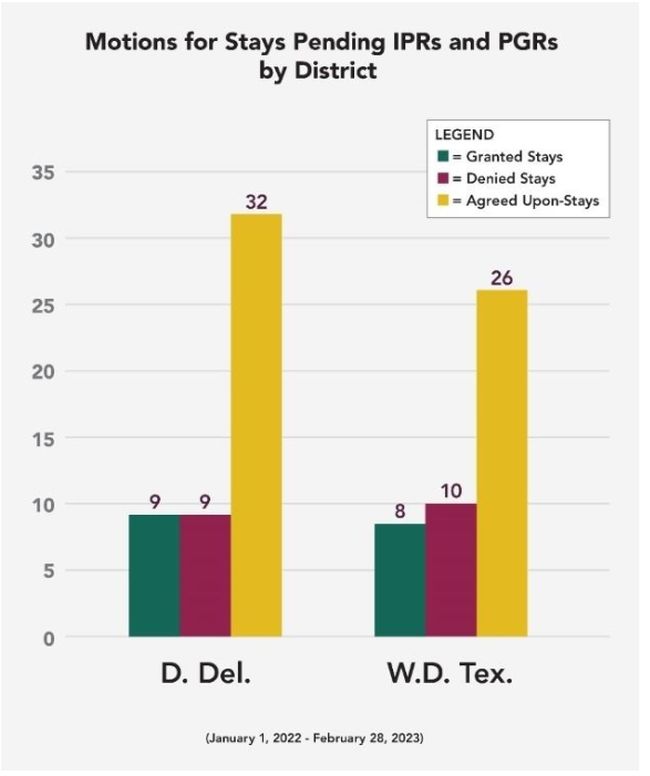
In deciding these motions, courts in both districts look at three factors: (1) whether granting the stay will simplify the issues for trial; (2) the status of the litigation, particularly whether discovery or claim construction is complete and a trial date has been set; and (3) whether a stay would cause the nonmovant to suffer undue prejudice from any delay, or allow the movant to gain a clear tactical advantage.
However, each district sometimes weighs these factors differently.
District of Delaware
The District of Delaware decided 50 motions to stay during the analyzed time period. Thirty-two were joint motions or stipulations, while the remaining 18 were contested. The court granted half of the contested motions, with the breakdown by judge shown below.
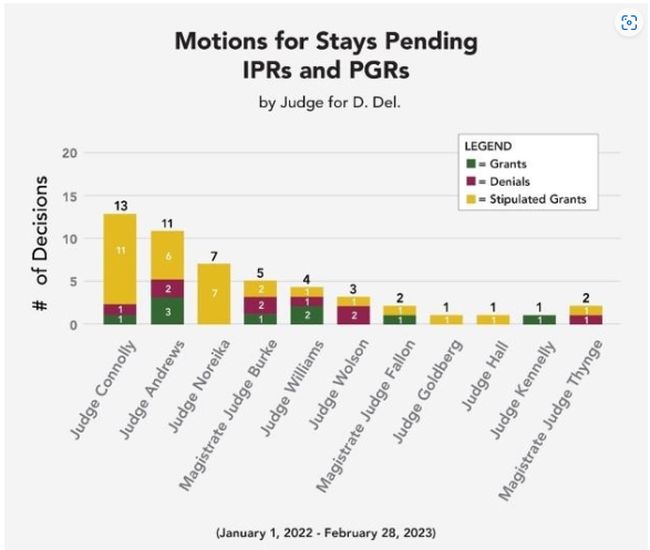
The following chart overviews the case progression for the 18 contested motions.
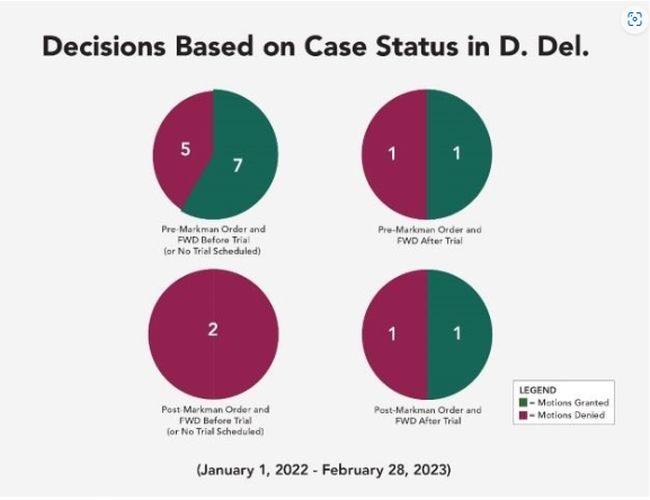
The decision in WSOU Investments LLC v. Netgear Inc.4 is exemplary of how this district balances the stay factors.
In WSOU, the court granted Netgear's motion and gave significant weight to the simplification effects because Netgear challenged all asserted claims at the PTAB.5
The decision emphasized that, without a stay, the PTAB's eventual final written decision (1) could nullify any work the court and parties complete during the PTAB proceedings and (2) "unduly complicate[s] [trial] proceedings" because the final written decision deadline was only one to two months before the scheduled trial date.6
The case was at the halfway mark with discovery well underway and a Markman hearing completed, but no Markman opinion had issued, and fact discovery remained open for at least three more months.7
Lastly, the court found that WSOU Investments would not be unduly prejudiced because the parties were not direct competitors and Netgear filed its inter partes reviews around the same time that it received infringement contentions.8
The court, however, denied a motion to stay in Tonal Systems Inc. v. iFIT Inc.,9 where Tonal sought declaratory judgment of noninfringement, iFIT counterclaimed for infringement, and then Tonal filed IPR petitions.
Tonal's motion to stay was denied because, although the litigation status was at the halfway mark, with fact discovery nearing close and Markman hearing upcoming, it was outweighed by the other two factors, finding that a stay would be unproductive because Tonal's IPRs challenged less than half of the asserted patents and did not challenge all asserted claims of any patent-in-suit, among other reasons.10
In some instances, one factor may heavily sway in favor of granting or denying a stay. For example, in LoganTree LP v. Fossil Group Inc.,11 the court found the lack of simplification from an IPR challenging only 32 of the 65 asserted claims undermined the fact that the case was in its early stages
The motion to say was denied because, "[r]egardless of whether [the] PTAB invalidates" the challenged claims, the parties would still have to litigate the remaining unchallenged claims.12
When deciding motions, the court has also considered the other nonprior art defenses that were not, or could not have been, raised at the PTAB.
CAO Lighting Inc. v. GE Lighting Inc.13 involved an inter partes reviews challenging all asserted claims, but the court found that the resolution would not simplify litigation because defendants raised numerous defenses outside the scope of the inter partes reviews, such as Section 112 arguments, inequitable conduct and equitable estoppel.14
Western District of Texas
The Western District of Texas decided 44 motions to stay during the analyzed time period.
Twenty-six were joint motions or stipulations, while the remaining 18 were contested. The court granted eight, or 44%, of the contested motions, with the breakdown by judge shown below.
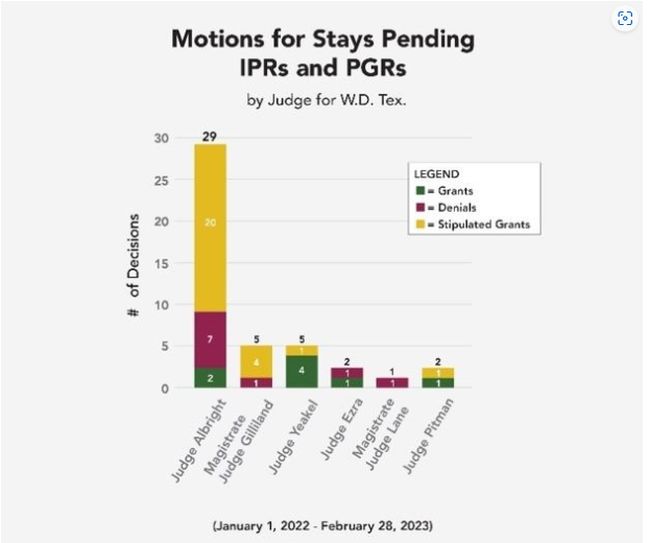
In July 2022, this district began randomly assigning patent cases to all judges.15 As more judges get involved in patent cases, it is helpful to understand how the court approaches motions to stay.
The chart below summarizes the case progression for the 18 contested motions.
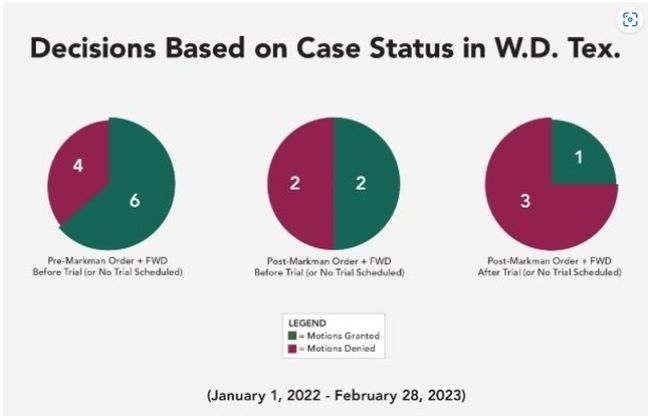
The Western District of Texas appears to analyze the simplification factor depending on the facts before them.
One decision found this factor to be the most important,16 and looked not only at the number of asserted claims or patents challenged at the PTAB, but also the strength of the overall inter parts reviews.
And, in Sonrai Memory Ltd. v. Western Digital Technologies Inc.,17 the court determined the strength of the inter parts reviews tilted the simplification factor toward a stay because the PTAB's institution decisions provided element-by-element analysis and found that multiple grounds were reasonably likely to succeed.18
Sonrai concluded that the benefits of simplification in that case outweighed the case progression and undue prejudice factors, which favored denial.19
In contrast, in Intellectual Ventures I LLC v. Hewlett Packard Enterprise Co.,20 the court found the IPR challenges were not sufficiently strong to favor a stay because the PTAB's institution decision stated that at least one of the challenged claims were reasonably likely to succeed, but this met only the initial institution burden and was not sufficient to show a likelihood to invalidate every asserted claim.21
This district has also considered other interests as part of the simplification factor. For example, the court has found that the simplification factor favors a stay based on the mere filing of an inter parts reviews petition in two cases22 and upon institution of inter parts reviews challenging only some of the asserted patents in another.23
In another case, the court has found that filing an inter parts reviews petition was not sufficient by itself because it was speculative whether the PTAB would institute24 and has denied a motion to stay based on a nonparty inter parts reviews where the defendant would agree only to a limited estoppel.25
With respect to the undue prejudice, at least one judge has stated that this factor typically favors denial.26
For example, in Sonrai Memory,27 the court found that the plaintiff faced undue prejudice because of (1) a risk of losing testimonial and documentary evidence from staying the case through any appeals of the inter parts reviews proceedings28 and (2) delay of the plaintiff's right to timely enforcement, although the latter was mitigated by the PTAB being scheduled to issue a final written decision before the scheduled trial date.29
The court has also found that mere delay, general interest in enforcement of a patent right, and risk of fading memories or lost discovery can be insufficient to deny a stay.30
For the case progression factor, the court, in Xylon Licensing LLC v. Lone Star National Bancshares-Texas,31 found that case progression favored granting a stay where "little-to-no judicial resources" had been expended and the PTAB's final written decision was expected to issue before the Markman hearing.32
In contrast, in Intellectual Ventures,33 the court found this factor favored denial because of the advanced stage of the proceeding with claim construction and fact discovery completed, a motion to transfer decided, and trial scheduled.34
Overall, this analysis shows that the stay factors may be weighed differently across districts and that each decision, and the weight, will turn on the specific facts of the case. Thus, it is important to consider both the factors in light of the specific facts and how the court has previously treated similarly situated cases.
Footnotes
1. T.e America Invents Act also created Covered Business Method (CBM) reviews; however, the time period to seek CBM review sunset on September 16, 2020.
2. T.e graph uses data from Docket Navigator.
3. T.is article looks only at complete grants and denials, and does not account for partial grants or denials without prejudice.
4. N.. 1-21-cv-01117, 2022 U.S. Dist. LEXIS 215391 (D. Del. Nov. 30, 2022).
5. I.., 1-2.
6. I..
7. I.., 2-3.
8. I.., 3-4.
9. 1.20-cv-01197, Dkt. No. 188 (D. Del. Feb. 09, 2023).
10. Id.
11. 1-21-cv-00385, Dkt. No. 65 (D. Del. Oct. 24, 2022).
12. Id., 2-3.
13. 1-20-cv-00681, 2022 U.S. Dist. LEXIS 227579 (D. Del. Dec. 19, 2022).
14. Id., 4-7.
15. Order Assigning the Business of the Court As It Relates to Patent Cases (W.D. Tex. Jul. 25, 2022) (J. Garcia).
16. Xylon Licensing LLC v. Lone Star Nat'l Bancshares-Texas, Inc., 6-21-cv-00302, 2022 U.S. Dist. LEXIS 103060 (W.D. Tex. Jun. 08, 2022).
17. 6-21-cv-01168, 2022 U.S. Dist. LEXIS 138603 (W.D. Tex. Aug. 4, 2022).
18. Id., 5-8.
19. Id., 8-9.
20. 6-21-cv-00596, Dkt. No. 104 (W.D. Tex. Dec. 22, 2022).
21. Id., 6-8.
22. MEETRIX IP, LLC v. Zoho Corp., 1-22-cv-00588, Dkt. No. 43, 3 (W.D. Tex. Feb. 28, 2023); Netlist, Inc. v. Micron Tech., Inc., 1-22-cv-00134, Dkt. No. 68, 3-4 (W.D. Tex. May 11, 2022).
23. Bell Semiconductor, LLC v. NXP Semiconductors, N.V., 1-20-cv-00611, Dkt. No. 114, 3-5 (W.D. Tex. Feb. 07, 2022).
24. Neo Wireless LLC v. Dell Techs. Inc., 1-22-cv-00060, Dkt. No. 91, 3-4 (W.D. Tex. Jun. 7, 2022).
25. Sonrai Memory Ltd. v. Texas Instruments Inc., 6-21-cv-01066, Dkt. No. 35, 3 (W.D. Tex. May 18, 2022).
26. Xylon Licensing, 2022 U.S. Dist. LEXIS 103060 at 4.
27. Sonrai Memory Ltd., 2022 U.S. Dist. LEXIS 138603 at 3-4.
28. Id.
29. Id.
30. Sonrai Memory Ltd. v. Oracle Corp., 1-22-cv-00094, Dkt. No. 68, 3 (W.D. Tex Jun. 27, 2022).
31. Xylon Licensing LLC, 2022 U.S. Dist. LEXIS 103060.
32. Id., 4-5.
33. Intellectual Ventures I LLC, Dkt. No. 104.
34. Id., at 5-6.
Originally Published by Law360
The content of this article is intended to provide a general guide to the subject matter. Specialist advice should be sought about your specific circumstances.

